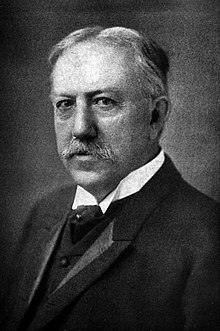
Back ديفيد ستار جوردن Arabic دايفيد جوردن ARZ David Star Cordan Azerbaijani دیوید استار جردن AZB David Starr Jordan Catalan David Starr Jordan Czech David Starr Jordan German David Starr Jordan Spanish David Starr Jordan Basque دیوید استار جردن Persian
David Starr Jordan | |
|---|---|
 | |
| 1st Chancellor of Stanford University | |
| In office 1913–1916 | |
| Preceded by | Office established |
| Succeeded by | Ray Lyman Wilbur |
| 1st President of Stanford University | |
| In office 1891–1913 | |
| Preceded by | Office established |
| Succeeded by | John C. Branner |
| 7th President of Indiana University | |
| In office 1884–1891 | |
| Preceded by | Lemuel Moss |
| Succeeded by | John Merle Coulter |
| Personal details | |
| Born | January 19, 1851 Wyoming County, New York, U.S. |
| Died | September 19, 1931 (aged 80) Stanford, California, U.S. |
| Spouses | Susan Bowen
(m. 1875; died 1885)Jessie Knight (m. 1887) |
| Children | 6, including Edith |
| Alma mater | |
| Profession | Ichthyologist, University President |
| Scientific career | |
| Fields | Ichthyology |
| Institutions | |
| Academic advisors | Andrew Dickson White |
| Doctoral students | Charles Henry Gilbert |
| Other notable students | |
| Author abbrev. (zoology) | Jordan |
David Starr Jordan (January 19, 1851 – September 19, 1931) was the founding president of Stanford University, serving from 1891 to 1913. He was an ichthyologist during his research career. Prior to serving as president of Stanford University, he had served as president of Indiana University from 1884 to 1891.
Starr was also a strong supporter of eugenics, and his published views expressed a fear of "race-degeneration" and asserted that cattle and human beings are "governed by the same laws of selection". He was an antimilitarist since he believed that war killed off the best members of the gene pool, and he initially opposed American involvement in World War I.[1][2][3]
- ^ "David Starr Jordan '72" (PDF). Cornell Alumni News. I (6): 39, 43. May 10, 1899. Archived (PDF) from the original on February 12, 2019. Retrieved June 15, 2014.
- ^ David Starr Jordan The Blood of the Nation: A Study of the Decay of Races through the Survival of the Unfit. (copyright 1902, reprinted 1910) p 12 Archived October 30, 2020, at the Wayback Machine. The term "race" occurs more than 30 times in the short book. The term "eugenics" is not in there, but the basic concept is described.
- ^ Abrahamson, James L (1976). "David Starr Jordan and American Antimilitarism". The Pacific Northwest Quarterly. 67 (2): 76–87. JSTOR 40489774.
© MMXXIII Rich X Search. We shall prevail. All rights reserved. Rich X Search